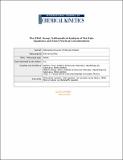Por favor, use este identificador para citar o enlazar a este item:
http://hdl.handle.net/10261/150353COMPARTIR / EXPORTAR:
 SHARE SHARE
 CORE
BASE CORE
BASE
|
|
| Visualizar otros formatos: MARC | Dublin Core | RDF | ORE | MODS | METS | DIDL | DATACITE | |

| Título: | The ORAC Assay: Mathematical Analysis of the Rate Equations and Some Practical Considerations |
Autor: | Arellano, Juan B. CSIC ORCID ; Mellado-Ortega, Elena CSIC; Naqvi, K. Razi | Palabras clave: | Antioxidant reactivity Chini Equation Lie symmetry group theory ORAC Peroxyl radical von Bertalanffy equation |
Fecha de publicación: | jun-2017 | Editor: | John Wiley & Sons | Citación: | International Journal of Chemical Kinetics | Resumen: | ORAC (Oxygen Radical Absorbance Capacity), a method widely used for measuring the total antioxidant capacity of biological samples, can also be used for the determination of the relative reactivity of an antioxidant compound (X-H) by examining the dependence of the rate of consumption of the probe (P-H) on the concentration of X-H; initial conditions are chosen in such a way that the rate of consumption of the starting reactants may be assumed to follow a drastically simplified kinetic scheme, and the steady state approximation for the concentration of the azo compound peroxyl (ROO•) radical is invoked to simplify the analysis. Here we first attempted to find an analytical solution to the coupled first order ordinary differential equations (ODEs) of the minimal ORAC kinetic system, applying Lie symmetry group theory without any precondition. However, the Lie symmetry transformations applied to the Chini equation, which appeared after mathematical transformations, showed that the form of the coefficients of the Chini equation precluded the analytical solution of the minimal ORAC kinetic system through symmetry reduction. Consequently, an approximate analytical solution was sought, valid for the case when the bimolecular rate constant of X-H with ROO• (i.e. kx ) was much larger than that of P-H with ROO• (i.e. kp ). Using numerical solution of the original set of ODEs of the ORAC kinetic system, the quality of the approximate solution was inspected under conditions that correspond to those employed in several ORAC methods together with a low initial concentration of the azo compound radical initiator. The simulations allowed us to conclude that the approximate analytical solution of the ODEs of the minimal ORAC kinetic system was not entirely devoid of academic interest, but its applicability was restricted to conditions where both kx >> kp and the initial concentration of X-H was higher than that of P-H. | URI: | http://hdl.handle.net/10261/150353 | DOI: | 10.1002/kin.21086 |
| Aparece en las colecciones: | (IRNASA) Artículos |
Ficheros en este ítem:
| Fichero | Descripción | Tamaño | Formato | |
|---|---|---|---|---|
| Arellano et al IJCK_submitted to IJCK.pdf | Articulo principal más material suplementario | 1,73 MB | Adobe PDF |  Visualizar/Abrir |
CORE Recommender
Page view(s)
276
checked on 15-abr-2024
Download(s)
324
checked on 15-abr-2024
Google ScholarTM
Check
Altmetric
Altmetric
NOTA: Los ítems de Digital.CSIC están protegidos por copyright, con todos los derechos reservados, a menos que se indique lo contrario.
